Marketplaces seem like they’re giving you a great deal. They promise to take the uncertainty out of running a freelance business. Where there once was nobody to pitch to, sites like Upwork make potential clients easy to find. Better still, these clients are actively looking for freelancers like you. Their wallets are practically out!
Their websites and systems have a nice familiarity about them too. They play to the logical side of our brains that tells us, “If people are looking to hire someone, they’ll post about it here,” in the same way a company would post about a new sales assistant role on Monster.
There are no barriers to entry and you can begin pitching for new work right away. The chances of landing new work are high, and as Brennan points out here, you can quickly start to make money from them.
But do these marketplaces really live up to the hype, and are they a good foundation to build your business upon?
Marketplaces Are Not Your Friends
The truth is, marketplaces are not designed for you to succeed. At least, not if you want to run a business where you can charge what you’re worth.
Instead, they’re designed for people who run “average” businesses to help them get work at a low cost. They want average workers, for average jobs, and to pay the lowest price for it. The client sets the price and you have to take it or leave it.
In an interview with Matt Barrie, who founded one such marketplace, Freelancer.com, James Altucher points out that hiring labour from the marketplace is affordable enough for someone to start a new business every month. He also calls it “the eBay of jobs,” because you can find a serviceable version of anything you need there for cheap.
That’s great if your an entrepreneur trying to start a business on a shoestring budget. But, not so great if you’re a freelancer trying to put food on the table.
Prices are also driven down further because of the amount of competition on these platforms. There are hundreds (if not thousands) of people pitching for any one position, forcing people to reduce their prices in order to stay competitive. It’s a never-ending race to the bottom.
In fact, FreelanceWriting.com found that the “Average” freelance writer was earning less than $14 a day when they tried to run their business through marketplaces. That’s $434 a month!
But, despite all of this people keep coming back to these marketplaces. Why?
Because their system is easy to use, it reduces uncertainty and simplifies the hardest parts of running a freelance business. This makes it a comfort blanket for freelancers who then become dependent on the platform.
Your income lives and dies by people coming to the platform. If it’s not on the board, it doesn’t exist. Which is a dangerous way to be running your business.
But, if marketplaces aren’t where you should be looking for clients, where should you be looking instead?
The Client Acquisition Pyramid
There are plenty of ways to find clients outside of marketplaces. In fact, marketplaces are at the very bottom of what I call the Client Acquisition Pyramid. There’s a whole world of new clients left to explore!
Let’s take a look at the pyramid to show you what I mean.
It’s divided into six different sections, each with a different level of profitability and difficulty:

Here are the six sections explained in more detail:
- Marketplaces: Lowest barriers to entry, lowest amount of payoff.
- Job Boards: These are one step above marketplaces. They’re a good place to start if you’ve never looked for clients outside of a site like Upwork before. Clients have a predetermined budget, but it’s usually higher than those on marketplaces.
- Cold Pitching: Cold pitching is a way of putting yourself in front of businesses or people, who could potentially need your services. This can be uncomfortable at first, but it’s an effective strategy. You can begin to negotiate higher prices for your work, and forge long-lasting relationships with clients.
- Seminars and Events: Industry events can be a great way to grow your funnel. Think of this as a more relationship-focused approach, and you’ll be building them over the long term. This can come with lots of high-paying, longer-term payoffs.
- Referrals: Once you’re established with clients, you can begin to ask them to refer you for other work within their network. Or you can ask if they know anybody you can get in touch with. This will give you access to clients you’d usually never find, and allow you to charge a premium rate, because you come recommended.
- Feeder Product and Social Media: These are clients earned by building a presence and audience online. You become the “go-to” person for your area of expertise and people go out of their way to find you. Highest barrier for entry but also the highest payoff.
Almost all freelancers can begin looking for work at the “Job Boards” or the “Cold Pitching” levels of the pyramid, depending on their experience or confidence levels.
Think of this pyramid a little bit like a department store.
Marketplaces are the bargain basement full of low-cost items nobody really wants. They’re just there to sell the product and not have it hogging space in their stock room anymore. But from the ground floor up, you’ve got the premium products people want to buy. They come with a higher price tag, and better quality to go with it.
If you wouldn’t want to buy from the bargain basement, don’t accept leads and clients who run their business in there!
You don’t need to look at each stage of this pyramid as sequential either. You can work on all of these levels at the same time or pick and choose the ones that are right for your business right now.
I tend to work on a long-term gain task, and a short-term gain task at the same time. For example, I might be cold pitching and trying to build my social media presence at the same time. (You could consider this blog post as part of that strategy).
Okay, now you understand why you should be moving away from marketplaces. Let’s now dig into how you can do that.
The Numbers Game Business Model
Getting your first freelance gigs outside of Upwork is all a numbers game so I’ve included a simple business model to help you gather data and improve your approach.
The more businesses or opportunities you pitch for, the more likely you are to find someone willing to hire you. Trust me, if you’re persistent, someone will take a chance on you.
One of the most important parts of playing the numbers game is tracking how many pitches you’re sending and how much work that brings in. It’s something many of us overlook (I know I did at the start!), but with this simple business model, that’s going to change.
All you’re going to need to set this up is a pen and a piece of paper. Or you can use a spreadsheet if you want to be fancy.
Before you write anything down, set yourself a target number of pitches to send each week. Ideally, this will be around 10 per day, but you can scale it to fit your needs.
Then, grab your piece of paper and draw three separate columns. With the headings “pitches sent,” “responses received,” and “clients booked.” Here’s one I made earlier:
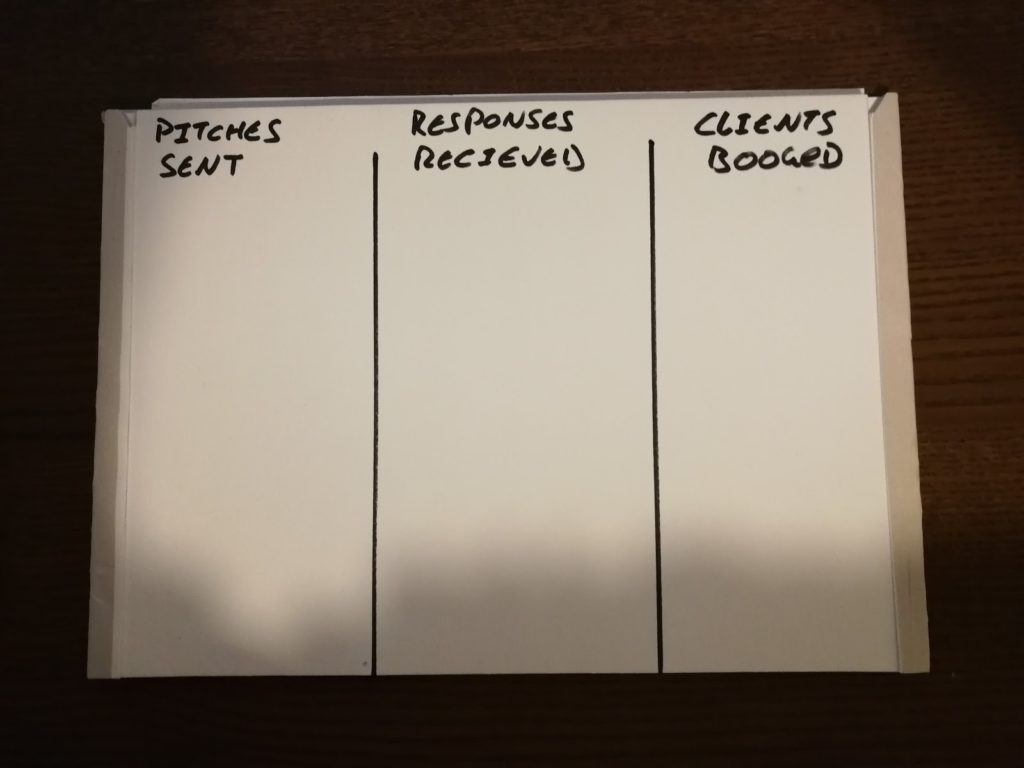
In the first column, you’re going to create a simple tally chart for every pitch you send. In the second column, you’ll create a second tally chart for every time you get a response (positive and negative). In the third column, you’ll create a tally chart of how many clients you’ve successfully booked for work.
After a few days of pitching, you should have something like this:
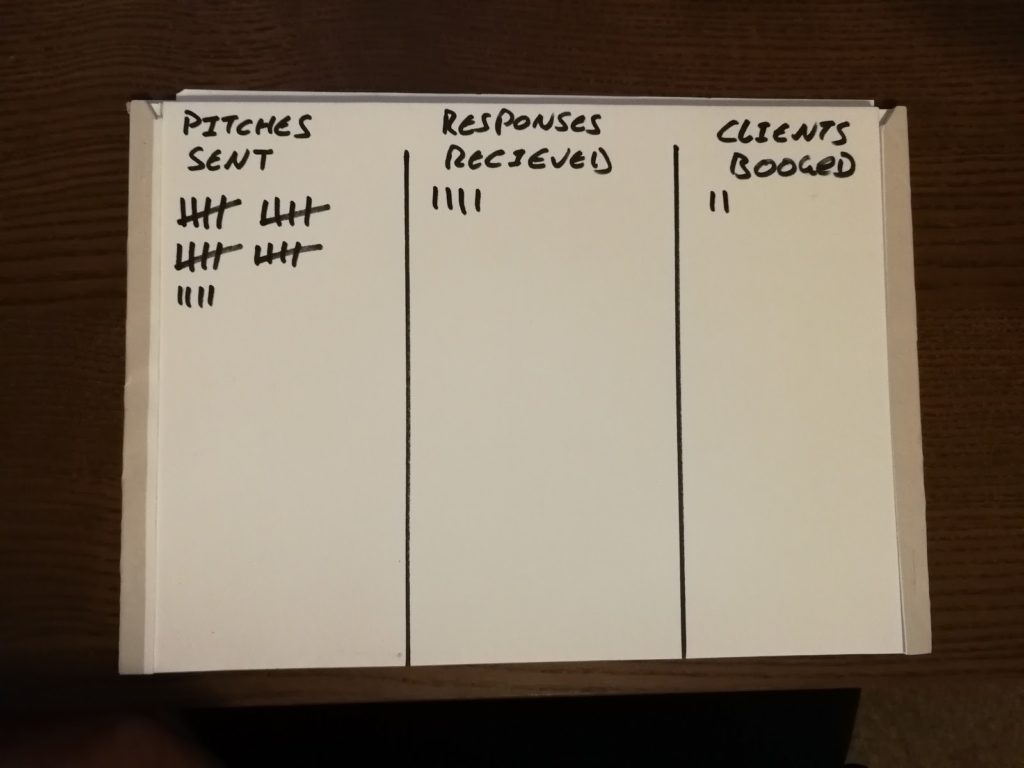
By doing this you’re giving yourself a simple way to track your input and see how much output it generates.
Let’s say you’ve sent 24 pitches. Those pitches result in four responses. From those four responses, you gain two paying clients. Now you can see on average, how many pitches you need to send to add a new client.
12, right? So 12 becomes your target number for how many pitches you need to send.
This might sound simplistic, but it works. If you make any changes to your process – like trying new subject lines or portfolio pieces etc. – you can track what is successful and what isn’t.
You can also use this model to see where you need to improve.
If you send 24 pitches, receive 12 responses and get zero clients, you can see that your pitches are okay, but your negotiations with clients need to be improved (or the clients you’re negotiating with). You can then use this data to make decisions and refine your approach.
Okay, with that in place, let’s move on to the two new methods you’ll be using to get clients.
Moving Beyond Marketplaces…
To begin your move away from the marketplace, you should start with either job boards or cold pitching.
You’ll be able to find much better, higher-paying clients using both of them whilst still seeing results quite quickly.
If you’re not feeling too confident, start with job boards. The process will be the most similar to what you’re doing now.
If you are feeling confident, dive in with cold pitching. You’ll have to invest a little more time upfront, but the payoff is worth it.
Set yourself the target of focusing on either one of these methods for the next four weeks. Give yourself time to improve your skills and get feedback before writing off either of them.
Method #1: Job Boards
Job boards are somewhere between marketplaces and cold pitches.
The standard of the client is higher and often has a bigger budget. There is still competition here, but prices aren’t driven as low.
I’ve developed some long-term relationships with clients from job boards, and find them a great tool to use if you ever need a quick cash injection.
Identify Your Job Board
The first step in this process is to identify the job board where you’re going to be looking for work. You can find this easily with an advanced Google search.
Head over to Google and type in your style of freelance work, followed by + job board. For example:
- Graphic design + job board
- Freelance writing + job board
- Developer + job boards
This will bring you two types of results. The first type is the job boards themselves:

The second will be a list of job boards that someone has (kindly) curated for you. They can make the research process a lot quicker:

Depending on your type of work, you may need to do a little more digging here.
There are sites like Gorkana and Indeed who run job boards for different types of freelancers not catered to by an independent job board. Be sure to look there too.
Find The Right Job
Each job board will contain a list of jobs and job descriptions. They all come with a headline and then a breakdown from the employer about what the job entails.
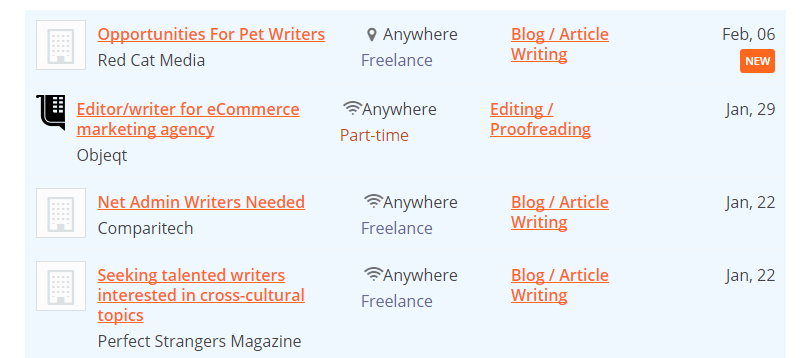
Before you click on a job, there is some information to help you decide if it’s going to be a good fit for you.
You’ll be able to see:
- Location: Where you need to be to work that job
- Hours: How much work is expected of you
- Company name: Who posted the job
- Published date: How long the job posting has been there
This is designed to entice (or deter) a certain type of freelancer, and you can already make an informed decision on whether it’s right for you. If it says full-time hours in San Bernardino, but you want to work part-time from a laptop in Bali, you can filter it out right away.
When you find a posting that grabs you, you can open it up. Inside you’ll find a job description that will be similar to the ones you saw on marketplaces. If it’s a good fit for you, it’s time to send your pitch.
Send Your Pitch (+ Sample Template)
You’ll usually have to pitch via email to the address provided in the job description.
Before you send your pitch you should read the entire job description two or three times. Really get familiar with what they’re asking of you, and generate some ideas of how you could help them out.
Also, be on the lookout for pieces of information that are there to trip you up. What do I mean?
Many people will include a simple instruction in the description, that you will complete in your pitch, to prove that you’ve read it. It’s often something simple like, “tell me your favourite joke” or “add ‘sweetcorn dolphin’ to your subject line”.
I’ve used this myself in the past to help me filter applicants out. I asked them to include Eccles RFC in their subject line. If they didn’t, they weren’t considered. It’s harsh but fair.
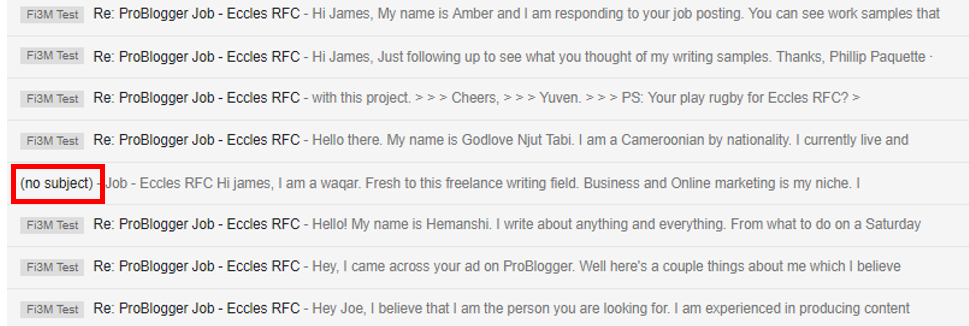
Below I’ve included a sample pitch that you can copy, paste, and edit to use when you’re writing to a potential client:
Subject: Re: Your [Job Board] Listing
Hey [name],
I know you must be getting a lot of pitches, so I’ll keep this brief….
My name is [your name], I’m a freelance [your profession], and I’m applying for your posting on [job board].
I’ve had the pleasure of working alongside companies like [X], [X] and [X], and I’d love the opportunity to work alongside you at [their company name] too.
Here are some of my samples:
- Sample #1 – [link to the sample] – [provide data or a tweet-sized summary of what the client wanted]
- Sample #2 – [link to the sample] – [provide data or a tweet-sized summary of what the client wanted]
- Sample #3 – [link to the sample] – [provide data or a tweet-sized summary of what the client wanted]
I’ve taken a look at [their website/project brief etc.] and I’ve come up with [number] quick [ideas/improvements] to achieve [their goals].
[Quick explanation of the ideas]
What do you think?
Thanks for your consideration,
[your name]
Once you’ve added in your information, hit send, add a number to your numbers game tally chart, and then go off in search of another opportunity!
Method #2: Cold Pitching
Cold pitching is finding businesses, people, or causes you’d like to work with and pitching to them for freelance work.
It requires a little more time investment than job boards or marketplaces, but the potential earnings are higher. You can also put yourself in the running for work that wouldn’t usually be advertised.
I noticed the first real positive shift in my earnings when I moved from job boards to cold pitching. Clients I generated through this method also lead to some of my highest paying referral work.
Although cold pitching can be an intimidating process, it’s worth investing your time into it. You can quickly build a well-paying client base to support you whilst you explore the higher levels of the acquisition pyramid.
Pitching Or Spamming?
One of the major concerns people have (which I’ve also seen Brennan bring up) is that cold pitching or cold contacting can sometimes feel like you’re “spamming” people. But I don’t look at it that way.
Let me show you an example of a spam email. I get emails like the one below on an almost daily basis through my website:

It’s not personalised. It doesn’t mention my needs. It doesn’t provide a solution. Its sole purpose is to get me to click on that dodgy looking link.
That, my freelancing friend, is spam.
What you’re going to be presenting people with is a personalised, benefit-driven email that builds a relationship with the other person. You have a solution to their problem, and you want to let them know about it.
As long as you’re sending a personalised message, that focuses on their business and their needs, and that hasn’t been copied and pasted to 300 different websites, you’re not spamming.
Narrow Your Focus
Finding your own leads can be a little bit overwhelming. There’s a lot of Internet out there, and it’s hard to know where you should begin looking.
In order to make this less overwhelming it helps to narrow down the industry by topics or types of business you want to work in. In other words, you want to find people in your niche.
(If you’ve not yet found your “niche,” I highly recommend you check out Brennan’s article on niching right here, then come back to this section.)
Let’s say you’re a freelance content writer who wants to work in the music industry. What kind of clients could you work for?
If you were to take 10-15 minutes to brainstorm all of the possible outlets in the music niche, you might come up with a list like this:
- Record companies
- Music magazines
- Concert reviews
- Music promoters
- Live music venues
- Festivals and event planners
- Record stores
- Recording studios
You could then take one of these subsections and focus just on that area until you’ve exhausted it.
If this still feels like too much to work with, you could narrow it down by location. Start off small and local and end up at a national level:
- Local record stores
- Record stores in the next major city
- Statewide record stores
- Record stores in the next state
- National record stores
Invest some time here and go deep into the categories and subcategories of places you could find new leads. The more targeted you can be, the less overwhelming it will feel. You’ll feel as though you have a plan you can keep working through.
And trust me, you’ll never run out of people to pitch to.
Find Your First Leads
With a focused idea of where to look, it’s time to look at the methods of how you can find your first potential clients to pitch.
Finding leads can be much easier than you think, and can all be done with free (or freemium) tools, meaning your only investment is time.
For the rest of this section, I’d recommend you use a spreadsheet like Google Sheets or Microsoft Excel to track your leads.
#1: Google Search
Google is by far the easiest place to begin looking for clients. Especially in a targeted niche or your local area.
For example, if you enter in “record labels + Manchester” you can find an entire map of relevant websites and businesses around me:

From here you can check out their websites and see if they’d be a good match for your services. You don’t need to apply for them just yet, instead just collect them into a spreadsheet.
Another cool tip here is to check out their business reviews. You can see what customers are saying about them and see if there is anything in there you may be able to help them with.
Here are some Google searches you can edit and use to help you find some leads:
- [niche/industry] + near me
- [niche/industry] + [your city]
- allintype:[your niche]
- related:[url of top website in your niche]
- [your niche] location:[your city or state]
Update the appropriate sections inside the [square brackets] and keep the structure intact.
#2: Industry Events And Their Partners
Even if you can’t personally attend, industry events are an easy way to find people to pitch to. There are events in your niche, both large and small, happening all over the world every week. And their websites can be a goldmine of potential clients.
Most of these events websites will have a page that says “Exhibitors” or “Partners.” These pages are filled with companies to target:

These tend to be companies that are actively trying to grow their business. That usually means they have a budget to hire freelancers to help them with their work too. Especially if what you’re proposing will also help them grow their income.
#3: Hire A Researcher
Although you’re not going to be working with them anymore, you can use marketplaces to your advantage.
If you have a little budget to spend, I highly recommend you hire a researcher through Upwork or a virtual assistant website.
You can set them a specific task like, “find 300 companies in my niche,” and they’ll pull together a spreadsheet of companies you can pitch to. The more specific your criteria, the better the results will be.
You can find more information on this in Brennan’s guide to pitching eCommerce clients.
Ready. Aim…
With a list of potential clients in place, you’re ready to start the process of pitching. For this I recommend you “group” the links you’ve acquired into batches of five, ten, or fifteen. You can tally these off on your simple business plan as you go through.
The first step I’d take is to go through the list of websites and filter out the results that aren’t a good fit for you. Websites you feel don’t need your services or don’t fit the type of clients you want to work with.
Some criteria you might want to look for (both positively and negatively) are:
- Freshness and design of the website
- Social media activity
- Marketing activity
- Grammar and spelling
- Audience engagement
- If their branding fits with the type of work you like to do
These will tick different boxes for different types of freelancers. For example, a terribly designed website doesn’t bode well for a writer, but it’s perfect for a graphic designer or developer.
What you’re looking for are things that either qualify or disqualify them as someone to pitch to.
If they qualify, take some extra time to rummage around their website and look at their work. Find things that you like, dislike, and think could be improved. This will come in handy in the next step. If they disqualify, just delete them from your list.
Once you’ve highlighted the sites you do and don’t want to pitch to, it’s time to find their contact details.
The simplest way to do this is to find the contact page on their website. There will either be an email listed or a contact form you can use to submit your pitch. (It might surprise you, but I’ve landed more than one client through the submission form).
There are also tools like Hunter, which is a free browser plugin you can use to display to the best email address of each website:
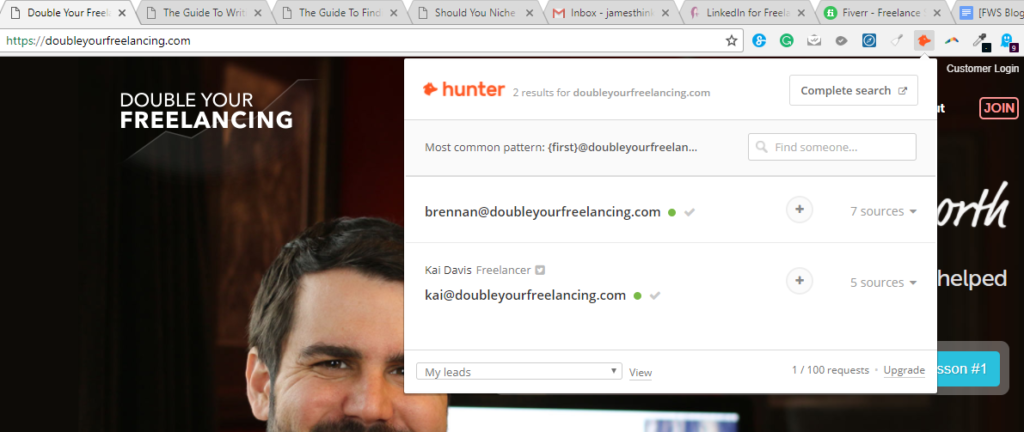
And, if the last two don’t work, you can be sneaky and find an email address on the legal page of their site, where they have to display it. But that’s a last resort.
Once you’ve filtered out and found the contact details, it’s time for the final step.
Pitch! (+ Your Cold Pitching Template)
Sending a cold pitch is a little different from applying for a job on a marketplace. That is why I want to help set you up for success with a pitching template.
In the last section, I mentioned you should look for pieces of work you like and places you feel they could improve. For this pitching email, you’re going to use both of them.
The main focus of this pitch is to add as much value to the reader as you can. This isn’t about you and growing your business, this is about them and growing their business.
As you’ll see in the template below, everything is focused on adding value to that person and framing you as the solution they need –with a little bit of personality thrown in because nobody wants to work with a drone.
Edit and use this template as you see fit, and don’t be afraid to get creative and update parts that don’t sound like you:
“Hey [Name/Company name],
I’m sure you’ve got a lot of emails to deal with so I’ll keep this brief…
My name is [Your name] and I’m a [your profession] from [your location]. I’ve been following [their company] for a little while now, and I really love the work you did with [the work you like that you found on their site].
I’d love the opportunity to work with you on [project or style of work that suits your skills].
Between cups of coffee I’ve been able to do [your style of work] for [client #1], [client #2] and [client #3] to help them increase [desired result for client]. Would you be interested in doing something similar?
Before you decide, I’ve pulled together some samples for you to take a look at, which I think you’ll really like:
[Sample #1] – [link to sample] – [quick summary]
[Sample #2] – [link to sample] – [quick summary]
[Sample #3] – [link to sample] – [quick summary]
You can also check out my testimonials [link] and the rest of my portfolio here [link].
I hope you don’t mind, but I’ve taken the liberty of coming up with some ideas of [relevant to your work] to help you increase [desired result to client]
- [Idea #1]
- [Idea #2]
- [Idea #3]
If you’d like to discuss these ideas further, I’d love to speak with you! You can email back here directly, or let me know when you’d be free for a [Skype/Phone] call.
Thanks for your consideration and take care,
[Your name]”
Leave Marketplaces Behind!
Marketplaces are not a freelancer’s friend.
If you want to create a business where you can charge what you’re worth and work with clients you love, now is the time to leave marketplaces behind! It may be daunting, but you can make the change and move a little higher on the Client Acquisition Pyramid through job boards or cold pitching. Job boards are similar to marketplaces, but with less competition and higher-paying clients. Cold pitching requires more upfront work but can lead to a bigger payoff. Both can help you gain lead independence from Upwork and pave the way for you to charge what you’re worth.
James Johnson founded Freelance Writers School where he teaches regular people how to start a freelance writing business in as little as 60 minutes a day. He’s English at heart but now lives in Cologne, Germany.
